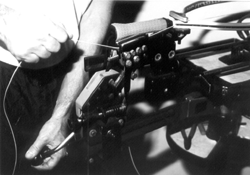|
|

Factory Direct Stringing
Does this "Freebie" Cost Your Game Too Much?

By discussing your strengths and weaknesses on the court, and the types of strings available, a professional stringer should be able to help you with a setup that will boost your performance-and offer you consistency from one stringing job to the next. |
By Steve Crandall
Vice President, Sales & Marketing
Ashaway Racket Strings
Has this ever happened to you? You buy a new racquetball racket, and then have to spend some time getting used to the feel of the string and the way it affects your game. Then, just when you have settled into a comfortable groove-BAM!-you break a string. "No problem," you think, as you trot off to your friendly racquetball stringer and request the racket be restrung according to manufacturer's recommendations for string and tension. You step onto the court for your first game with your newly strung racket. But as soon as you start to play, you suddenly realize that everything is different-the feel of the racket, the tension of the string, the bite (or lack thereof) on the ball. And you find yourself starting from scratch, getting used to a new string setup.
This is exactly the problem I recently discussed with a reader. Having come across this frustrating situation several times, he finally called his racket manufacturer to ask if he could send his racket back to be restrung by them. Their response surprised him. Not only does the manufacturer not offer restringing services, but they insisted that his racket would never play like new due to changes to the racket itself that occur as the result of the initial stringing job.
This answer may or may not be true. Even with strict quality control checks in place, a lot can happen to a racket between the time it rolls off the manufacturing line and the time it appears in your local sporting goods store. The majority of rackets are manufactured offshore, predominately in Asia, and Asian manufacturers use a wide variety of stringing techniques, equipment and string. The rackets are then packaged in bulk and shipped around the world, being stored in warehouses and on retail shelves before ultimately being purchased by racquetball players. All of this introduces a lot of opportunity for the factory string job to vary from the original specifications.
And even though some racket manufacturers may assure you that stringing results are reproducible if you stick to their recommended string and tensions, the reader's concern does raise an interesting question: is playing with factory string the best choice for your game? Playing with the factory string does have some advantages. First is cost: it is admittedly cheaper to play with the string that comes as a "freebie" with the racket than to buy new. Second is convenience: playing with factory string allows for one-stop shopping. In fact, you could pick up a new racket on your way to the game without missing a beat.
A third factor is that recreational racquetball players often do not devote a lot of time to learning about string materials, gauges and tensions, and how all of these characteristics affect performance. They assume that racket manufacturers string their rackets for the "average" racquetball player, and that the string job will be "good enough." And while in large part that may be true, it will not take your game to the next level, or help when you need to restring.
Many serious racquetball players have followed the lead of some of the top professional racquetball players, who immediately cut the factory strings out of new rackets, and have them restrung with their favorite high performance string by a stringer they know and trust. These players are willing to go to this extra effort because they rely on their string to give them the extra power, control, or bite that they need to push their game to the next level. Also, they need to know that they can rely on their rackets to be strung consistently. When a string breaks in the middle of a game, there is no time to adjust to a new string setup. Points are on the line, and the next racket they grab must give them the same level of performance they started the game with. We will discuss this subject in more detail in an upcoming column, in which we'll take a peek into the stringing habits of a top IRT pro.
Top tennis players do not have to go the extra step of removing factory strings, because in the tennis industry a full 80% of all performance rackets are sold unstrung. Why? Because these players want to customize their racket string and setup to meet their playing needs-not adapt their style of play to an existing string job. And, by using the same string and stringer, players ensure that the string setup will be consistent from one job to the next. Perhaps someday racquetball racket manufacturers will offer their performance frames unstrung for just this reason.
As with all racket string issues, whether to play with the factory string or to restring with a professional stringer is a personal choice. If you would like to customize your string setup, but are unsure about what to do, talk to your stringer. By discussing your strengths and weaknesses on the court, and the types of strings available, he or she should be able to help you with a setup that will boost your performance-and offer you consistency from one stringing job to the next. You can also visit our web site at www.ashawayusa.com for more racquetball stringing tips, and to learn more about what might work best for you.
This article previously appeared in Racquetball Magazine.
|